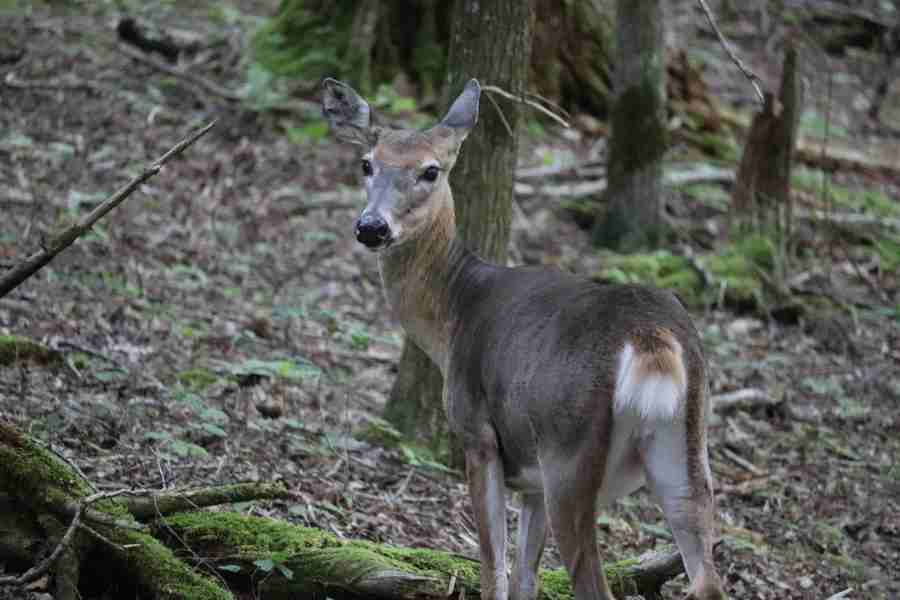Deer are known for their keen senses, which they employ to avert danger whenever possible. For the average hunter, success hinges upon beating these senses, preventing detection.
However, this feat is seldom accomplished without a keen understanding of a deer’s abilities, whether regarding hearing, sight, or smell.
When attempting to understand the depth of a deer’s senses, many hunters question whether or not deer can see color.
This is quite an intriguing question in its own right and one that is not as easily answered as one might expect.
What colors a deer can and cannot see is quite complicated.
Contents (Jump to Topic)
ToggleWhat Do Deer See?
Contrary to popular belief, deer do see color. However, deer interpret these colors in an entirely different manner than humans.
Due to the makeup of a deer’s eye, many colors are not as easily distinguished from one another as most would think.
In fact, deer are incapable of perceiving the colors red and orange. On the contrary, shorter wavelength colors, such as blue, are recognized quite easily.
read.. what does deer poop look like
In reality, evidence suggests that deer can see and recognize the color blue to a far greater extent than humans.
Some researchers even speculate that deer can see the color blue up to 20 times better than humans. Deer are also known to see much deeper into the UV spectrum than the typical human.
These sight characteristics are influenced by the distinct configuration of a deer’s inner eye. Previous studies have concluded that a typical deer’s eye contains significantly more rods than cones, enabling enhanced night vision.
However, this comes at the cost of reducing color detection and recognition.
Of additional interest is that deer appear to have difficulty distinguishing between specific colors.
read.. most hunted big game
Most notably, deer are red-green color blind, seeing no real difference between each. It is also currently unclear whether or not deer can correctly distinguish between shades of gray and tan.
Additional Facts About Deer Sight
There are several other key characteristics regarding a deer’s sense of sight outside those mentioned above.
Each of these characteristics is worthy of recognition by hunters due to their potential impacts on the results of a given hunt. Understanding a deer’s sense of sight is the first step to evading detection.
One of the most important factors for hunters is that deer have an exceedingly wide field of view.
Deer can analyze up to 300-310 degrees of their surroundings at any one time without turning their heads. This means that deer can only see what is positioned directly behind them.
Deers can also process and react to what they see more quickly than humans. It is widely accepted that deer process images 2.5 times quicker in low light and two times faster in standard light than humans.
This proves extremely valuable when attempting to avoid predators in various situations.
Additionally, it is widely accepted that deer can see to a much greater distance than humans, albeit in far less detail. This means that deer can pick out the finest movements, even at a great distance.
However, that which is seen will be pretty vague. This is why holding completely still is a hunter’s best defense against being spotted by deer.
A deer’s eye also features a horizontally oriented, oval-shaped pupil. The shape of this pupil is ideal for gleaning additional light at or below the horizon level.
Still, it proves to be a limiting factor when looking above the horizon toward the skyline.
This irregular pupil shape proves ideal for recognizing predators at ground level.
What Does This Mean For Hunters?
This information can be used by hunters when attempting to remain hidden from a whitetail’s watchful eye.
Perhaps most importantly, one should remember that deer more than make up for what they cannot distinguish in color with their ability to identify movement, even at a great distance. For this reason, hunters should remain as still as possible while on stand.
It is also wise to avoid wearing clothing that features blue or purple while on stand. Deer can easily recognize these colors against an otherwise bland background, making you stand out indefinitely.
It also appears that the typical hunter-orange safety vest is not readily visible, as deer do not see nearly as well within the orange/red color spectrum.
You should also avoid washing your hunting clothes in any laundry detergent with a UV brightener.
Since deer can see well into the UV spectrum, clothes washed in UV brightener-enriched detergents are easily noticed.
It is believed that this excess UV causes garments to reflect a noticeable amount of white light or color when viewed by deer.
In most cases, a hunter will get away with much more movement when hunting from an elevated platform than on the ground.
This goes back to the fact that deer see much better at or below eye level than above it due to the distinct shape of their pupils. This likely explains the significant popularity associated with hunting from a treestand.
Does Camouflage Work?
With the latest research on deer eyesight being widely published, many have begun questioning the true effectiveness of camouflage.
In truth, the verdict is still out regarding how well camo hides a hunter. While it is likely that camouflage patterns break up a hunter’s outline, there is little evidence to support the notion that newer, high-definition camo patterns are any more effective than patterns of old.
This stems from the fact that a deer’s eyes cannot assess fine detail as that of humans.
At the very least, you should understand that even the best camouflage is no substitute for sitting completely still and remaining patient on-stand.








